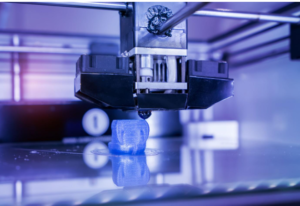The manufacturing industry is undergoing a transformation with the advent of Industry 4.0, and metal 3D printing is playing a pivotal role in this
transformation. This innovative form of additive manufacturing is drastically changing the way companies approach mass production across a
wide range of industries, including automotive, aerospace, healthcare, and consumer products. Metal 3D printing offers unparalleled agility and
flexibility, making it an ideal technology for large-scale manufacturing operations.
What is Metal 3D Printing?
Metal 3D printing involves the process of making a three-dimensional, solid object of nearly any shape or design from a computer-generated
framework. It is one of the different types of additive manufacturing that has been around for a few decades. However, it has started to gain
widespread attention in recent years. Typically, fine metal powders are used in the process. They are layered and bonded together using
bonding agent between each layer. Metal additive manufacturing enables the production of complex components with intricate designs in various
markets, regardless of the size of the order.
How Does Metal 3D Printing Work?
The majority of 3D metal printers use laser-based technology to create metals. To create a physical item, it combines powdered material with a
powerful laser beam that melts the powder particles layer by layer. The printer keeps layering powders in accordance with the product design
until it produces the right structure.
There are two different technology categories: laser metal deposition and powder bed. The metal deposition
process works by accumulating material layers until the pattern is constructed. On the other hand, in powder bed methods, the 3D printer uses a
printing bed on which the powder metal is fused to create the desired shape.
Different Technologies of Metal 3D Printing Used For Mass Production
The following technologies are used for mass production using metal 3D printing:
Single-Pass Jetting
Single-pass jetting is a metal 3D printing process that involves depositing a layer of powdered metal onto a platform and then selectively fusing
the metal particles together using a high-energy source such as a laser or electron beam. This process is involves constructing a layer on a layer
until the final part is complete.
One of the key advantages of single-pass jetting is its ability to print complex geometries with high resolution and accuracy. Additionally, the process is very fast compared to other metal 3D printing techniques, enabling the production of high volumes of parts
in short time.
This speed and precision make single-pass jetting an attractive option for mass production, particularly for small to medium-sized
metal parts with intricate geometries. The process can also be easily automated, increasing its efficiency and suitability for mass production.
Anti-Sintering Layers
Anti-sintering layers are thin layers of material that are added to the surface of a metal 3D-printed part during the printing process. These layers
act as a barrier to prevent the sintering (or partial melting) of adjacent layers of metal powder during printing.
The anti-sintering layers aim to ensure that each layer of metal powder remains distinct and separate, allowing a higher level of precision and
accuracy in the final part. Without anti-sintering layers, the sintering of adjacent layers can cause distortion, warping, and other issues that can
compromise the quality of the part.
Anti-sintering layers are particularly important in mass production because they help ensure consistent quality and reduce the need for post
processing and finishing. By preventing sintering between layers, the layers can be built up quickly and efficiently, allowing faster production
times and increased throughput.
Stackable Builds
Stackable builds in metal 3D printing refer to the ability to print multiple parts at once by stacking them vertically, one on top of the other, within
the build volume of the 3D printer. This allows more efficient use of the printer’s capacity and can help increase the speed and production
volume.
Stackable builds are particularly useful in mass production because they enable the printing of multiple parts simultaneously and
eliminate the need for additional build plates or post-processing steps. This can significantly reduce the time and cost associated with
manufacturing large numbers of parts.
In addition, stackable builds can help optimize the use of materials, as multiple parts can be printed from a
single batch of metal powder or filament, reducing waste and improving overall efficiency. This can also result in cost savings for manufacturers,
making metal 3D printing a more cost-effective option for mass production.
Cloud-Based Automated Production
Cloud-based automated production in metal 3D printing refers to the use of cloud computing and automation technologies to manage and
streamline the entire metal 3D printing process from design to production. This includes software tools for design, simulation, and optimization
along with automated production systems that can run around the clock without human intervention.
Cloud-based automated production can help increase the efficiency and speed of mass production by enabling real-time data analysis
and optimization. For example, data from sensors on the 3D printer can be analyzed in real-time to identify and address the issues before they
emerge as big problems. This process reduces downtime and improves overall throughput.
In addition, cloud-based systems can help streamline the entire production process by enabling automated scheduling, material handling, and
post-processing. This can reduce the need for manual intervention and increase the speed and efficiency of production.
Benefits of Metal 3D Printing For Mass Production
Metal 3D printing is a powerful tool for mass production and offers numerous benefits. This makes it an attractive option for manufacturers
looking to optimize their production processes and meet the demands of a rapidly evolving market. Let us discuss some advantages of metal 3D
printing for mass production:
Improved design flexibility and customization
Metal 3D printing enables the production of complex geometries and structures that may not be possible with traditional manufacturing methods.
This flexibility also allows the customization of individual parts or batches, making it easier to adapt to changing customer needs and
preferences. In addition, metal 3D printing allows quick design iteration and optimization, reducing the time required to develop new products.
Cost savings and reduced lead times
Metal 3D printing can help reduce the time and cost associated with traditional manufacturing methods such as injection molding or CNC
machining. With metal 3D printing, manufacturers can produce parts more quickly and with fewer resources and reduce labor costs, material
waste, and tooling costs.
Enhanced quality and precision
Metal 3D printing offers high precision and accuracy, resulting in consistent quality and repeatability across large production runs. The technology
also allows the creation of complex geometries with tight tolerances and the ability to produce parts with minimal defects or errors. These
characteristics reduce the need for post-processing and improve the overall product quality.
Reduced waste and increased sustainability
Metal 3D printing generates less material waste as compared to traditional manufacturing methods, as the metal powder or filament is used only
where it is needed. This can lead to considerable cost savings for manufacturers and a reduced environmental impact. Additionally, metal 3D
printing offers the potential for closed-loop recycling, in which unused or excess metal powder is reused in subsequent prints.
Most Popular Industries That Use Metal 3D Printing
Metal 3D printing has numerous applications across a wide range of industries. Here are some of the most popular industries that use metal 3D printing:
Aerospace Industry
Metal 3D printing is particularly well-suited for aerospace applications due to its ability to produce complex geometries and lightweight parts.
Aerospace manufacturers use metal 3D printing to produce turbine blades, fuel nozzles, and other critical components.
Parts that are commonly made using 3D metal prototyping are interior aircraft components, tools for composites, combustor liners, UAV parts,
engine segments, and oil and fuel tanks.
Automotive Industry
Metal 3D printing is increasingly used in the automotive industry to produce complex parts with high precision and accuracy. Automakers use
metal 3D printing to produce engine components, suspension systems, and other parts that require high strength and durability.
This technology is used by industry giants, including Porsche, Ford, VW Group, and Audi, to produce various automotive parts. Although rapid
metal prototyping cannot be utilized to create finished parts, it is extensively used to build cars in batches. The most widely used components
include cradles, tools, brakes, spare parts, and fittings.
Medical Industry
Metal 3D printing is also used in the medical industry to produce customized implants and prosthetics. The technology allows the creation of
patient-specific parts tailored to individual needs, resulting in better patient outcomes. Metal 3D printing is used to create various body parts,
such as implants, prosthetics, braces, crowns, aligners, dentures, and much more.
The technology has made it possible to conduct some ground-breaking tissue-engendering research. Printing the skin tissue has been made
possible recently by researchers at the University of Toronto. This breakthrough will now be used to test for drugs, treat burns, and address other
skin-related problems.
Conclusion
In conclusion, metal 3D printing is transforming the manufacturing industry by offering a range of benefits for mass production. As technology
evolves and becomes readily accessible, it is expected that metal 3D printing will play an even greater role in mass production, enabling
manufacturers to produce high-quality and customized products more efficiently and cost-effectively than ever before. By embracing this
technology, manufacturers can stay ahead of the competition and position themselves for success in the future.
About the Author
 Sunanda Ghosh is a researcher with more than 3 years of experience. She has a passion for understanding consumer behavior and market
Sunanda Ghosh is a researcher with more than 3 years of experience. She has a passion for understanding consumer behavior and market
trends, and uses her skills in innovative ways to gather and analyze data. Throughout her career, she has worked with a diverse range of global
clients across various industries including technology, semiconductor, and energy. She is dedicated to providing valuable insights that can help
shape a company’s direction and drive success.
The author can be reached at sunanda.ghosh@nextmsc.com



